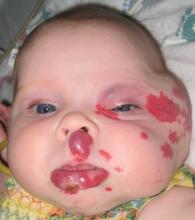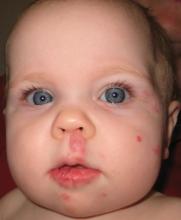Propranolol is more clinically effective and cost effective than oral corticosteroids for infantile hemangiomas, and should be considered a first-line treatment, according to the results of a new study published online Aug. 15 in the Archives of Dermatology.
In what the researchers described as the first large, retrospective study to directly compare the two treatments, patients who were given propranolol showed more effective clearing of lesions, were less likely to require surgery for residual lesions, and had minimal adverse effects. Propranolol also was half as costly as corticosteroids, according to Dr. Cynthia J. Price of the University of Miami and her associates.
"Until recently, the mainstay of treatment for infantile hemangiomas has been corticosteroids in various forms, including topical, intralesional, and oral formulations, with the most common being oral prednisolone. Only in complicated or refractory [infantile hemangioma] cases have other treatment modalities, such as interferon alfa-2a, imiquimod, vincristine, cyclophosphamide, pulsed dye laser, and, most recently, propranolol, been considered," the investigators wrote.
Propranolol, a nonselective beta-blocker, is presumed to act on these lesions through vasoconstrictive properties. The drug reduces the release of nitric oxide, inhibits proangiogenic signals (such as those from vascular endothelial growth factor, basic fibroblast growth factor, and matrix metalloproteinase 2/9), and induces apoptosis in proliferating endothelial cells.
For the study, Dr. Price and her colleagues reviewed the charts of 110 patients with infantile hemangiomas who were treated at two Miami medical centers in 2005-2010. Their mean age at the start of treatment was 4.5 months.
Slightly more than half of the study subjects were white, 45% were Hispanic, and 1% were black. Most of the lesions were located on the head (59% on the face and 19% on the scalp), and the rest were on the trunk (7%), extremities (10%), and genitalia (5%).
Abnormalities were found on radiographic examinations in 14% of the patients, and included multifocal hemangiomatosis with diffuse liver involvement. Brain MRI revealed abnormalities in nine patients, including aberrant carotid artery connections feeding the hemangioma, extension of the lesion into the brain, and extension into the eye.
In all, 68 patients were treated with propranolol and 42 with oral corticosteroids. The two groups were matched with respect to age as well as the location, size, and type of lesion.
Fifty-six patients (82%) who were given propranolol achieved clearance of 75% or more of the lesion after a mean of 8 months of treatment, compared with only 12 (29%) of those given oral corticosteroids for a mean of 5 months, the investigators reported (Arch. Dermatol. 2011 Aug. 15 [doi:10.1001/archdermatol.2011.203]).
Patients who were given corticosteroids had to discontinue treatment significantly earlier than did those given propranolol because of adverse effects. The rate of adverse effects was 100% with corticosteroids, compared with only 1% with propranolol.
The single adverse effect that was likely related to propranolol was hypoglycemia, which developed in one patient. In contrast, all of the patients who received oral corticosteroids developed cushingoid features, and 14 developed various steroid-related disorders including gastroesophageal reflux, hypertension, hirsutism, and infections.
One patient who took corticosteroids had a life-threatening arterial bleed from a lesion ulceration that eroded through the carotid artery and required emergency surgery. The rate of lesion ulceration was significantly lower with propranolol (6%) than with corticosteroids (26%).
The number of patients who were referred for surgical treatment of residual hemangioma also was significantly lower with propranolol (12%) than with corticosteroids (29%).
The average cost of treatment was $205 per patient for propranolol, not including the charge for a cardiology consultation for clearance to start treatment. This is less than half the cost of $416 per patient for oral corticosteroids treatment, which doesn’t include the additional costs incurred by treating or preventing adverse effects.
Until now, "it has been believed that therapy must be administered during the proliferative phase of infantile hemangiomas to arrest the progressive growth of the vascular lesion. However, in this study, we found similar outcomes in patients treated with propranolol before and after 1 year of age (7 of 68 patients were started on propranolol therapy after the age of 12 months, and all had [at least] 75% clearance)," Dr. Price and her associates noted. "This finding indicates that propranolol’s long-term effect is not solely related to it antiproliferative effect on the vasculature but is also due to its apoptosis and vasoconstriction."



